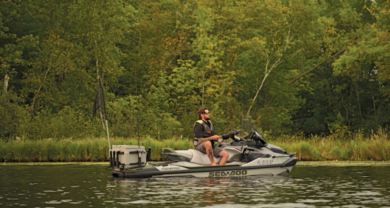Market Trends: Freshwater fishing boats growing larger, more sophisticated
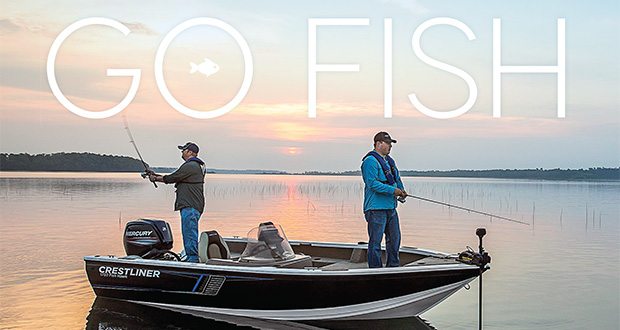
For years, recreational fishing has ranked as the single most popular activity that people enjoy from a boat. According to the National Marine Manufacturers Association and the Recreational Boating and Fishing Foundation, that remains true today.
In its Special Report on Fishing published last year, the RBFF notes that no fewer than 46 million Americans participated in recreational fishing during the 2014 calendar year, representing 15.8 percent of the U.S. population aged 6 and older. Freshwater fishing draws more than three times the number of participants as saltwater fishing, representing a total of nearly 38 million people. Little wonder that the freshwater fishing segment remains among the most durable markets in the U.S. boating industry.
Recent data from Statistical Surveys confirms that the freshwater fishing market continues to exhibit modest growth in the mid-single digit range each year. According to SSI, in 2013 dealers sold a total of 53,371 outboard-powered aluminum fishing boats in the United States. That figure grew to 56,788 boats in 2014, representing growth of 6.4 percent. For calendar year 2015, U.S. dealers sold 59,085 freshwater fishing boats, a further 4.0 percent jump.
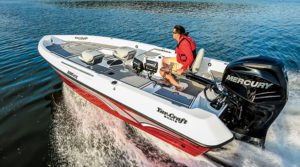
Sales of fiberglass freshwater fishing boats were lower in terms of overall unit volumes but follow a similar trend, growing from 7,577 boats in 2013 to 8,031 boats in 2014 for a 5.9 percent gain. For 2015, dealers sold 8,561 fiberglass freshwater fishing boats, representing a 6.5 percent gain.
What is particularly interesting is that these increases significantly outpace growth in the U.S. population overall. According to the U.S. Census Bureau, the U.S. population grew from 317.5 million in 2013 to 320 million in 2014, an increase of just 0.7 percent. The national population grew to 322.5 million in 2015 for a similar 0.7 percent gain. The conclusion that sales of freshwater fishing boats are outpacing overall population growth is consistent with RBFF data that shows steadily increased interest in freshwater fishing.
Where it really gets interesting is when you consider SSI’s annual sales figures from a geographical perspective. Traditionally, aluminum boats have sold best in the northern U.S. and Canada, while fiberglass has historically reigned supreme in the south. But that no longer appears to be necessarily true. In 2015, for example, dealers in the Dallas–Fort Worth area enjoyed the third strongest sales volumes of aluminum fishing boats in the country, outpacing northern markets like Chicago and Detroit. At the same time, dealers sold more fiberglass fishing boats in Minneapolis than they did in strong southern markets like Nashville, Dallas and Houston. The key takeaway is clear – where freshwater fishing boats are concerned, anything goes.
The bass market
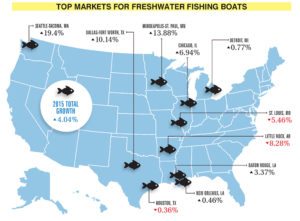
While the overall freshwater fishing market has enjoyed steady, modest growth, one particularly bright spot has been in the bass boat segment. Sales of bass boats grew by a whopping 29.9 percent in the 12-month rolling period ending February 2016, according to SSI.
“In the overall market we are seeing good sales of the lower-priced product, where buyers are more cost-sensitive and are able to take advantage of attractive financing terms,” said Bass Cat and Yar-Craft Boats President Rick Pierce. “But we’re also seeing good sales in the top end of the market, in that $50,000 to $100,000-plus price range. We’re seeing more Jaguar sales now than we ever have, and those are big boats with 350 horsepower outboards.”
Growth at each end of the pricing spectrum can be explained by basic demographics, says Pierce. While boomers take advantage of continued low interest rates to buy increasingly higher-end boats, the entry level is being fueled by a new generation of bass anglers rising from high school and college tournament circuits.
“We’re seeing tremendous activity in high school bass fishing, and we’re seeing similar growth at the collegiate level,” said Pierce. “These kids are active and they’re engaged. For us, it’s bringing back a lot of the mid-level. The parents don’t want the kid driving a 20-foot boat with a 250 on it, they want to start them on something smaller and less powerful, like a 19-footer with a 150. For us, that represents a growth opportunity because many of these kids will become lifelong anglers, and will move up to larger boats down the road.
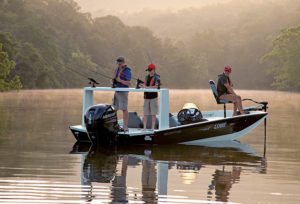
“The challenge in the freshwater market is that we lost what I call the Nintendo generation, which would be buyers in that 30 to 45 age range,” he continues. “You just don’t see many of them. These are the people who grew up with Gameboys and video games, instead of growing up developing an interest in the outdoors.”
Pierce feels the bass market is doing well, even if it still has a way to go before it returns to pre-downturn levels.
“Back in the 1980s, the bass boat market alone was a 55,000 to 57,000 piece market, shared by dozens of manufacturers. Today, it’s about a 10,000 piece market that’s split between a handful of us,” he said. “We’re seeing it come back to where it was before the recession, and we’re seeing more stability. The growth in college bass angling is encouraging.”
The aluminum core
While the bass market may be experiencing faster than average growth, it is the aluminum V-hull that represents the core of the freshwater fishing boat market. The aluminum V-hull segment didn’t suffer the post-downturn crush as badly as some other segments did, and the consensus is that it’s currently operating at somewhere around 70 percent of its pre-downturn volumes.
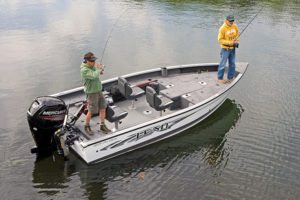
category, says Brunswick’s Jeff Kinsey.
“People tend to view a fishing boat as part of their lifestyle,” said Jeff Kinsey, president, Brunswick Freshwater Boats. “You might use it to take the family for a cruise around or to try water sports, but its primary purpose is to catch fish. So as a consequence they aren’t subject to whims, people don’t use the boat for a few years then decided to go get another one. The ownership cycle is a bit longer, and people don’t seem to turn over their boat as quickly as what might be seen in some other segments.”
With category growth in the mid single-digit range, the aluminum fishing category is responding to consumer preference for more versatile boats that can do more than just fish. Families want boats that can also go for an after dinner cruise or a picnic on a distant island, or pull the kids around on a tube.
“Having said that, you cannot sacrifice the basic fishability of the boat,” said Kinsey. “You can add new features, but you can’t compromise the boat’s capability as a fishing platform. The engineering challenge then is how to add capabilities without interfering with its basic design. The average price of the boat has gone up out of proportion to the unit gains, because people want their boat to do more.”
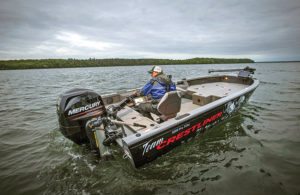
Key additions include amenities like pull-up jump seats in the rear casting deck, removable seat cushions that convert the bow casting deck into a sunpad, and bimini tops for sun protection.
“There’s more demand for storage, and more purposeful use of storage spaces,” said Kinsey. “There’s also increased demand for greater electronic integration.”
Literal growth
When one talks about growth in the aluminum boat market, it’s hard to overlook the physical growth of the boats themselves. With the addition of all those extra family-friendly amenities, freshwater fishing boats can’t help but grow bigger and more expensive.
“Over the past three years the standard 16-foot fishing boat has become an 18-foot or 19-foot model,” said Phil Smoker, vice president of sales for Smoker Craft Inc. “Three years ago there were maybe 12,000 aluminum 16-foot boats sold in the U.S., and last year it was down to about 10,500. But at the same time, three years ago there were 10,800 18-foot boats sold, and last year it was up to 13,470. So the most popular boat size is now an 18-foot, rather than the traditional 16-footer. The bigger boats allow you to add the family features while retaining the core fishing features that are critically important to buyers.”
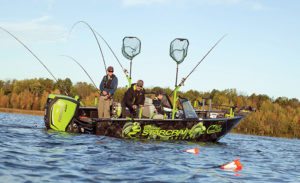
Of course, moving a larger hull with additional features requires larger, more powerful engines. Where the standard 16-foot aluminum boat probably had a 50 horsepower outboard on the back, today’s 18-footer more likely to come with a 90 or a 115, said Smoker.
“The development in outboards has paralleled the developments in boats,” he says. “Today’s outboards are very, very quiet. They’re smooth, they troll down to a crawl, the fuel economy is tremendous and they’re almost maintenance-free so you can just get in the boat and go.”
(Editor’s note: Read more about the latest outboard trends in the May issue of Boating Industry.)
Those bigger boats with bigger engines naturally carry bigger price tags. So while sales volumes demonstrate modest growth, increases measured in dollars are far more substantial.
“The average price of the boat has gone up out of proportion to the unit gains, because people want their boat to do more and have more power,” said Kinsey. “That seems consistent across the entire product line, and there has been growth from the value end to the premium product. The angler seems to be aware of what they can afford, and they will go get the best boat they can at that price point. As a result, we’re seeing growth throughout the product lineups, as opposed to the barbell type of distribution where the entry level and high end sell well, and the mid-line gets squeezed out. Entry level is still holding steady to about where it was a few years ago, while the mid and premium products are increasing.”
Cross-category competition
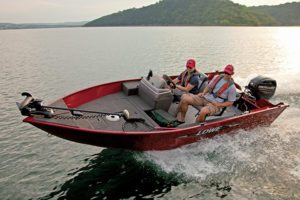
As the freshwater fishing boat becomes more adaptable and family-friendly, it is bound to appeal to a wider range of buyers. At least in some markets, aluminum V-hulls with full windshields and versatile seating arrangements have begun to find new buyers among customers that would traditionally purchase a fiberglass bowrider.
“In Canada, particularly, we are seeing the multi-purpose fishing boat with the full windshield and family seating begin to edge into what was once the domain of the runabout,” said Smoker. “They’ve become more accepted as general purpose cottage boats, mainly due to their adaptability. We’re not seeing that to the same degree here in the U.S., although there are a few places where that might be happening.”
The tendency toward aluminum fishing designs as multi-role cottage boats in Northern markets may also reflect consumer belief that aluminum hulls can better handle occasional scrapes against rocky bottoms than fiberglass hulls might. That perception has long fueled a preference toward aluminum hulls in Northern markets.
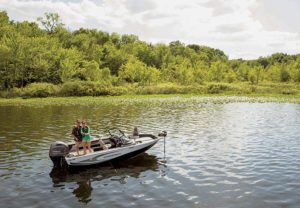
The irony with cross-market competition is that it often proves to be a two-way street. While freshwater fishing boats may be experiencing some market growth at the expense of fiberglass bowriders, they themselves are increasingly coming into competition with pontoons.
“We build both fishing boats and pontoons, and we do sell a number of pontoon boats with full fishing packages, including pedestal seats, rod racks and live wells,” said Smoker. “It’s a popular option in some markets.”
Putting regional variances aside and viewing the overall market from a continental perspective, cross-category gains and losses likely cancel one another out. Which leaves the freshwater fishing category looking very good indeed. With steady volume growth in the mid-single digit range and a clear trend toward larger boats representing higher corresponding dollars and margins, the freshwater fishing market is a good place to be.



